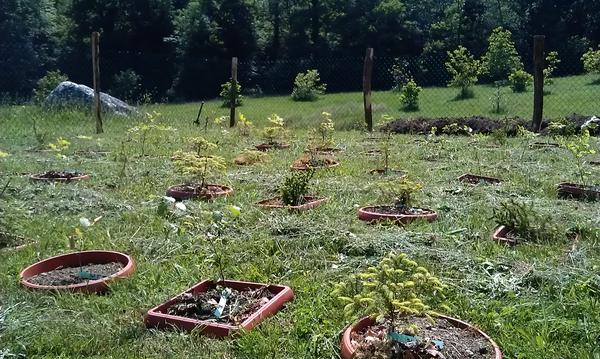How our forests are adapting to climate change

© 2017 EPFL
How do trees adjust to the effects of global warming? EPFL researchers have studied how beech and spruce trees – two of the most common plant species in Europe – react to changing temperatures. And they discovered that the amount of moisture in the air plays a decisive role.
Rising temperatures, increasingly intense rainfall and extended periods of drought are some of the known effects of climate change. But how are trees reacting to them? To find out, a team of researchers from EPFL and the Swiss Federal Institute for Forest, Snow and Landscape Research (WSL) studied two of the most common plant species found in Switzerland and the rest of Europe: beech and spruce trees. The study,* which was recently published in Global Change Biology, revealed that each species reacts differently, with the amount of moisture in the air playing a greater role than was previously thought.
"To find out what forests may look like in the future, we have to understand how each plant species will respond to climate change," explains Constant Signarbieux, the scientist in charge of the study, which was carried out at EPFL’s Ecological Systems Laboratory (ECOS).
The researchers observed five-to-seven-year-old saplings of the two species for four years, from 2012 to 2015. The saplings were collected at the Col du Marchairuz in the Jura mountains during the colder months, and then replanted in three locations at different altitudes: in the small village of St-Georges (at 1,010 meters), in the Vallon Arboretum in Aubonne (at 570 meters), and in the grounds of the EPFL-run Fondation des Bois Chamblard on the shores of Lake Geneva (395 meters). A fourth group of saplings was kept at its original altitude of 1,350 meters and used as a control group.


Young trees at the Aubonne's site, and one reference tree at Marchairuz. (c)ECOS
"Transplanting these young trees at lower altitudes meant we could simulate the impact of an average temperature increase of between 1 and 6°C, in keeping with what is forecast to occur between now and 2100 based on a number of climate-change scenarios,” explains Signarbieux.
To beech or not to beech?
By regularly measuring each tree's trunk and four main branches, the researchers were able to estimate the trees’ biomass. They noticed that the rise in temperature prolonged the growing season – the period from when the first new leaves or needles appear in the spring until they turn yellow in the autumn – in a similar way for each species. However, the two species demonstrated very different biomass growth. The beech trees did well from the rising temperatures, flourishing quickly and becoming more easily acclimatized to the warmer temperatures than the spruce trees. "Spruces are a more conservative species and perhaps adapt more slowly," says the researcher. "This could have an immediate impact on our forests, as beech trees are more likely to be predominant going forward."
The researchers didn't stop there. They wanted to learn more about why the two species grew at different rates – and the reason came as quite a surprise. Their analyses revealed that it had nothing to do with either photosynthesis or the amount of water in the ground. Instead, it was all down to the vapor-pressure deficit (VPD) – the difference between the amount of moisture in the air and the maximum amount of moisture the air can potentially hold at a given temperature. This gives an indication of how dry the air is and how much pressure the plant's water system is under as a result.
It’s all about suction
A plant's leaves contain microscopic pores, called stomata, which regulate how gases move between the leaves and the atmosphere. "Plants use these stomata to absorb CO2 from the air through diffusion," explains Signarbieux. "When the pores open to let the gas in, water escapes from the leaves at the same time. This process is known as transpiration and occurs because there is always more moisture in the plant than in the air. It is what creates the suction that pulls water and sap from the soil through the roots, up the stalk and into the leaves."
The drier the air, the higher the VPD and the greater the suction effect will be. When there are several consecutive days with a high VPD – an ever more regular occurrence due to climate change – plants are put under increasing strain. But different plants react in different ways, as shown by the two species studied. Even before there is no water left in the ground, spruce trees close their stomata to prevent any more hydric stress. Beech trees, however, are more tolerant of this type of stress and wait longer before closing their stomata, which enables them to continue absorbing CO2 and therefore keep growing. This gives them a competitive advantage over the spruces.
In the past, average seasonal or annual temperatures and rainfall were used to analyze plants' responses to their environment. But those factors alone don’t explain why the beech and spruce trees grow at such different rates. What makes this study truly original and groundbreaking is that the researchers took account of another variable that is often overlooked: the number of hours during which the VPD was above a certain critical level, indicating that the plant was experiencing exceptionally dry conditions. The biologists now intend to expand their research to other species, in the hope of creating a graphic representation of what Europe’s forests will look like in the future – and to help ensure that they are managed and used sustainably.
*Conducted as part of the doctoral thesis by Paula Sanginés, a researcher in the ECOS lab.